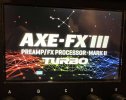Having owned a Mk II and now a couple of Turbos, I can assure you there is a discernable difference.
Some pre-planning on how your preset development journey will look over time will help predict future needs. For example, about a year ago I started experimenting with double tracking and this became addicting. All of my presets now double track my guitar. I'll even throw in IR transform such that one sounds like a completely different guitar. Suddenly, the audience is hearing a strat and a tele, or a strat and a PRS and thinking we have a second guitarist. This can be very cool, but now, out of the gate, I have at least an IR block or two, two amps and two cabs and I haven't gotten to the icing, yet. Start throwing in some effects, 12-string simulation capabilities, feedback simulation, virtual capos, multi-band compression and suddenly you can find some creative ways to max out even a turbo.
I acknowledge I am an extreme case, and one could argue that I don't need all of that on each and every preset and they would be correct. But having a turbo allows me to run one template that I use across all presets, which greatly simplifies my midi control structure and post FW release updates. This is probably the most important to me since I also run a preset per song. You can imagine that preset standardization immensely simplifies my life. I share my case example just to provide some food for thought while you are making a decision.

